The Cottage Inn, Wembdon, was for a long time the only pub in the village, and has a long history.
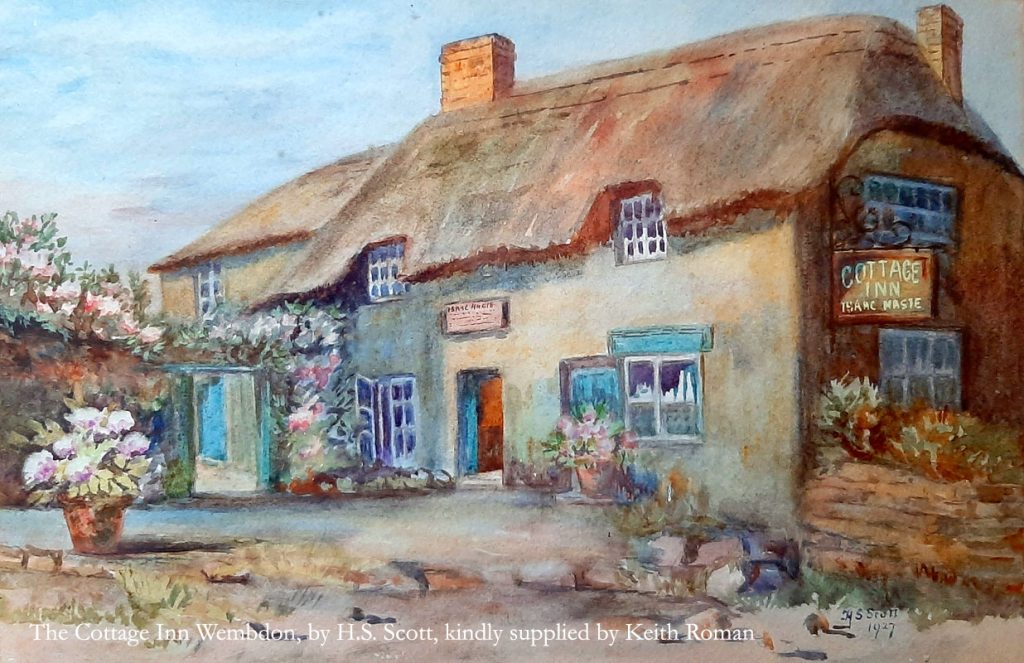
The earliest map to show the cottage seems to be the 1802 Ordinance Survey Map, although in no special detail. It comes more into focus in the 1840s Tithe Apportionment map and schedule for Wemdbon parish, when the cottage and garden are numbered 285. At this time it was owned and occupied by a John Collier. The land for the cottage and garden seems to be hived off of the big square field next to it, which was called ‘Kilve Close’ (although ‘Kiln’ has also been suggested). Kilve as a placename means something like ‘eminence’, so probably refers to the summit of the hill.[1] There is quite a sharp rise to the ground behind the modern buildings, possibly suggesting this plot had to be carved out of the rock through quarrying before it could be occupied. That sharp rise, may explain why the old cottage projected so far into the road.
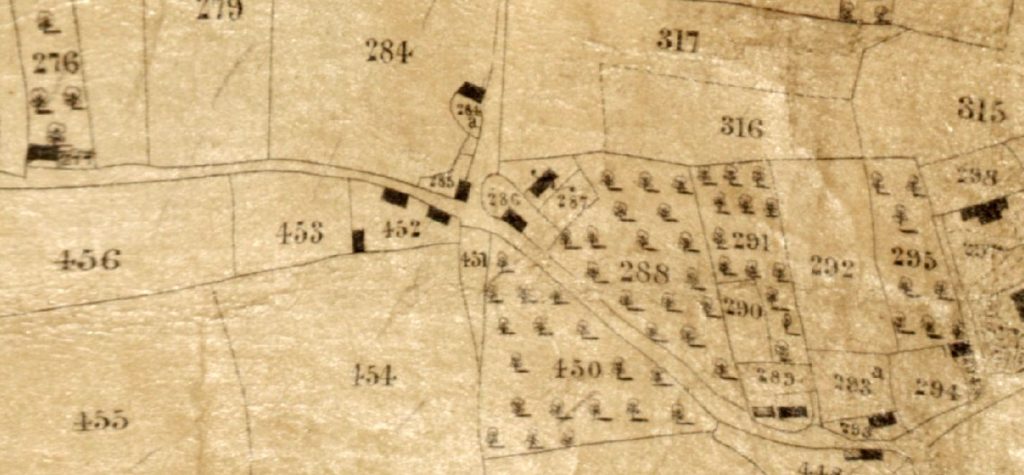
The only Collier family in Wembdon in the 1841 census are listed two properties further on from Coker’s Farm, with the property of Thomas Edney in between (Hoxton House, now 108 Wembdon Hill). The household was headed by William Collier, a 31-year-old carpenter, with Ann Collier, 21 years old, probably his wife, then 3-year-old William and 1-year-old James. Either the tithe map got William’s name wrong, or John was William’s father. Mind, in the following 1851 census, by which time they had moved to Wembdon Road, his name is now ‘James’. Either way, it seems that the cottage at this time does not yet seem to be an inn, but instead the home of a labouring family, and possibly his workshop too. Families would often have a side-line offering hospitality to travellers, so it could be have been a simple ale/guest house at this time. Some accounts suggest the Cottage Inn can be traced to 1743, although we’ve not been able to find evidence for it that far back – again something less formal than a full inn may have operated from the cottage.
It is difficult to trace the cottage in the 1851 census, but it seems to be in the occupation of George Poole 23-year-old cordwainer (someone who makes leather shoes – as opposed to a cobbler who repairs shoes), who was from St Decumen’s in Williton. His wife was 24-year old Mary Ann from Bridgwater, and living with them were their one-year-old son Thomas, Francis Taylor (Mary Ann’s father) and Emily Parsons, a house servant.
George seems to be the founder of the Cottage Inn. The earliest mention of the Cottage Inn we’ve found so far is June 1860, when Mr George Poole is described as landlord. In other reports it’s called ‘Poole’s Cottage Inn’.[2] In the 1861 census we find a snapshot of the household, with George (now described as innkeeper) and Mary Ann, son Thomas, with the addition of 6-year-old son Ernest. Caroline Coles lived with them as a servant. This wasn’t the first inn or pub in Wembdon, although it’s now the oldest: Hoxton House, already mentioned, was once the Wembdon Inn, and at the other end of the hill was the Rock House Inn, also called the Templar’s Inn, opposite Skimmerton Lane.
Although the Cottage is shown as a modest-sized building on the 1840s Tithe Map, it was sufficiently extended that it could host large numbers of people by the 1860s. The Inn was able to host the West Somerset Yeomanry in October 1863, although how much of the drinking was done outside is unclear. The yeomanry were cavalry, meaning there would have been a lot of horses to look after outside.[3] A club room is mentioned in 1867, when it hosted the Wembdon Friendly Society. This was a fund raising day, and the friendly society was essentially a local members club that provided a form of insurance for people in hard times and bad health. The society had formed in 1855. The numbers attending that day aren’t mentioned, but some 87 members at the inn in June 1876. They congregated there in the morning, then, led by the band of the Somerset Rifle Corps, they paraded round the village, before returning for a meal. After dinner they paraded again, then returned for drinking and dancing.[4]
The clubroom is presumably the large, long building shown on later maps, and must have been built by Poole. It survives today, modified in 1937, and its two section might suggest it was built in two phases, although that might just be to cope with the incline of the hill. The western portion retains its old chimney, while the middle portion was more heavily modified to bring it in line with the 1938 portion. The club house range may have also included accommodation for guests, while the other small buildings shown as well will have included stables, storage, and the privy (outside toilet). The map below and painting above also show a simple mid-nineteenth-century extension behind the old cottage, and that possibly survives as part of the modern buildings today as well. The 1911 census mentions six rooms including the kitchen. There were probably two or three rooms for guests therefore, assuming two rooms for the family.

Poole was still landlord in 1867, but seems to have left in late May 1868, when the Hurfords took over.[5] Like cordwaining, innkeeping doesn’t seem to have suited him (despite laying the foundations for a very strong village institution) as in the 1871 census he was now a farmer at Clay House Farm in Cannington.
The new residents and innkeepers were Frederick Tutton Hurford and Jane Hurford. Jane’s maiden name was Poole, and later describe her place of birth as ‘Willington’ or ‘Watchett’, so presumably George was able to pass the Cottage Inn to close relatives. Frederick was living in Bridgwater in 1841 and gave it as his place of birth in the 1871 and 1881 census, but married Jane at Wilton, Taunton in 1850, and both were described ‘of this parish’. Frederick had possibly moved there as an apprentice or jobbing stonemason, and they seem to have moved around before settling in Wembdon, given the place of birth given for their children as Watermouth and Plymouth in Devon.
The 1871 census described Frederick (aged 47) as a marble mason, while Jane (aged 45) is described as landlady. Their 19-year-old son Samuel was working with his father as a marble mason, and also living there were 17-year-old son James (occupation ‘nothing’), 11-year-old daughter Minnie, 9-year-old son Frederick, 5-year-old son Willie and 2-year-old son John.
From this we can assume Jane was doing the majority of the domestic and supply work as innkeeper, while Frederick and Sam worked as marble masons. Frederick Hurford is mentioned in the 1841 census working as a stone mason in North Street, under his father Samuel, where there was a stone mason’s yard, so these two presumably worked there during the days and helped in the pub in the evenings.
Jane would become very well respected locally, and was a formidable personality. In 1872 she apprehended a thief, John Williams, who had stolen a salted pig’s cheek from the Inn. Jane followed him down the hill, snatched back the cheek and had him arrested.[6] In February 1874 Frederick is mentioned in the papers, having been assaulted by Robert Parker, who had arrived drunk one evening and had been refused drink.[7] The previous year he had been fined for permitting drunkenness on his premises.[8]
In 1876 the front wall of the inn was damaged by an out of control wagon. Its doubtful this was the first time a vehicle crashed into the building, and it would certainly not be the last.[9]
We see the household again in the 1881 census. Frederick is described as ‘Publican and Stone Mason’. Still living at home were Minnie, Willie and Tom. Frederick died in 1883, leaving Jane to run the inn for the rest of her life. He was buried in St George’s churchyard on 20 August. He was just 59 years old. He left an estate worth £91, 7 shillings and 6 pence. In the 1891 census we find Jane (licenced victualler), Minnie (assistant to the above) and Tom Poole Hurford (cabinet maker)
Through the later years of the nineteenth century we find mentions of all the usual activities and sports we’d expect from a rural village inn. Along side those mentioned already, the club room is mentioned again in 1892, where the Cannington and Wembdon Agricultural Association retired to after a sheep shearing match.[10] Jane was fined in June 1889 for selling beer out of hours.[11] Property auctions would also be held here from time to time.[12] For a number of years the West Somerset Vale Foxhounds would gather at the Inn before the hunt, as well as the Bridgwater Harriers.[13] The Cottage Inn also seems to have served as a small grocer’s shop as well.[14]
One of the less joyful activities held in the inn were inquests. Many appear in newspaper reports over the years, and some bodies were bought here over quite long distances, which suggest the facilities at the inn were especially well suited to provide space for inquests, but also a discreet place to keep the bodies:
- January 1861: Unknown infant male child, about two weeks old, murdered, whose body was discovered in a lane known as ‘Sandford Water’ near the Cannington Road. The child had been stabbed in the neck (Western Daily Press, 24 January 1861; Sherborne Mercury, 29 January 1861).
- April 1866: Alfred Duckham, 18 year old tile moulder, shot himself in the head after the father of the women he was courting refused to let him see her (Somerset County Gazette 13 April 1867)
- May 1868: Benjamin Pollard, yeoman, found dead at the bottom of Sandford Hill after drink driving (Western Gazette 1 May 1868)
- February 1873: Gideon Gillingham, 45 year old road builder, found frozen to death (West Somerset Free Press, 15 February 1873).
- May 1877: Harriet Brown, alias Palmer, aged 56 years, found drowned in a rhyne on Chilton Road (Somerset County Gazette 19 May 1877).
- November 1881: James Biffin found dead on a path to Cannington, assumed suicide (West Somerset Free Press 19 November 1881)
- June 1889: Mary Ann Sellick, five months old, a child born of incest in Perry Green, found suffocated (Central Somerset Gazette 1 June 1889).
- July 1891: Harriet Stone, aged 60, accidentally poisoned (Shepton Mallet Journal 10 July 1891)
- October 1897: Minnie Poole Hurford, aged 38, daughter of the windowed landlady Jane Hurford (‘greatly esteemed in the neighbourhood’). Died suddenly of a brain haemorrhage (West Somerset Free Press, 16 October 1897).
- February 1906: Harry Wilkins, aged 38, carter, crushed against a wall when his wagon lost control on the hill (Taunton Courier, 21 February 1906).
- February 1908: George Stone, aged 59, retired farmer, died suddenly of a heart attack (Shepton Mallet Journal, 14 February 1908)
- March 1924: Unnamed Female Infant, found floating in the pond of Mount Radford Quarry, having apparently been strangled. The body had been thrown from the lane (Taunton Courier, Bristol and Exeter Journal and Western Advertiser, 26 March 1924)
- February 1928: Stanley Boobyer, aged 26 of Boroughbridge, killed when his motorcycle collided with a stone pillar on Mount Radford (Taunton Courier, 15 February 1928).
In the 1901 census we find Jane still working away as innkeeper. Living with her were son Samuel Poole Hurford, described as a French Polisher in a Carriage Works, then his wife Rosa ‘assistant to mother in law’. Sam and Rosa had a 1 year old son, Herbert.
Jane Hurford died in 1906. Her obituary is glowing:
DEATH OF MRS J. HURFORD – Our obituary this week contains an announcement of the death of Mrs Jane Hurford, the much-respected landlady of the cottage Inn, at the advanced age of 80 years. She had been in failing health for several weeks past, and her death will be mourned by a large circle of friends, by whom she was deservedly held in great esteem. Deceased, who was a native of Williton, held the licence of the Cottage Inn for the extended period of 38 years, and for a considerable time had acted as sub-treasurer of the Wembdon Friendly Society, in the welfare of which she always manifested a good deal of interest. The funeral took place in the parish churchyard on Tuesday afternoon.[15]
Tom and Rosa took over the pub after she died. However, tragedy would strike only a few years later. In the April 1911 census we find Tom described as an unemployed French Polisher, and Rosa described as the innkeeper. They had three children, 11 year old Hubert, 7 year old Annetta, and 1 year old Marjorie. Tom was killed that September while attempting to help during a disastrous fire at a nearby farm owned by the Day family. Tom had climbed a ladder to help quench the flames in the roof, but was overcome by the smoke, fell, and broke his neck.[16] To compound the tragedy, in February 1912 Tom’s daughter Marjorie Minnie, aged just 2 years and 10 months, died suddenly. Rosa, the mother, must have been devastated.[17] Later that year a ‘Miss Hurford’ of the Cottage Inn Wembdon, left England for Toronto, Canada. Presumably this was Rosa off to start a new life.[18]
It is not clear who took over the inn from here. Kelly’s directories for Somerset tell us that William Gay Chown was landlord in 1914, while William Thomas Vicary was landlord in 1919.
In 1922 the Inn narrowly avoided an out-of-control steamroller, which ended up in the wall of Hollywell, destroying a good portion of it.[19] The landlord by 1927 was Isaac Haste, as indicated by the painting of the Cottage by H.S. Scott above.[20]
The old cottage part of the Cottage Inn was demolished about 1937. In May 1938 there was discussion of reducing the brow of the hill in front of the inn ‘in connection with improvements carried out at the junction’, which suggests the beautiful old building with its crescent-shaped garden, both of which jutted out into the road, even beyond where the modern pavement stops, were perhaps demolished as a road-widening exercise.[21] John Roman, who lived in the cottages behind the inn on Hollow Lane, took these pictures of the demolition in process.
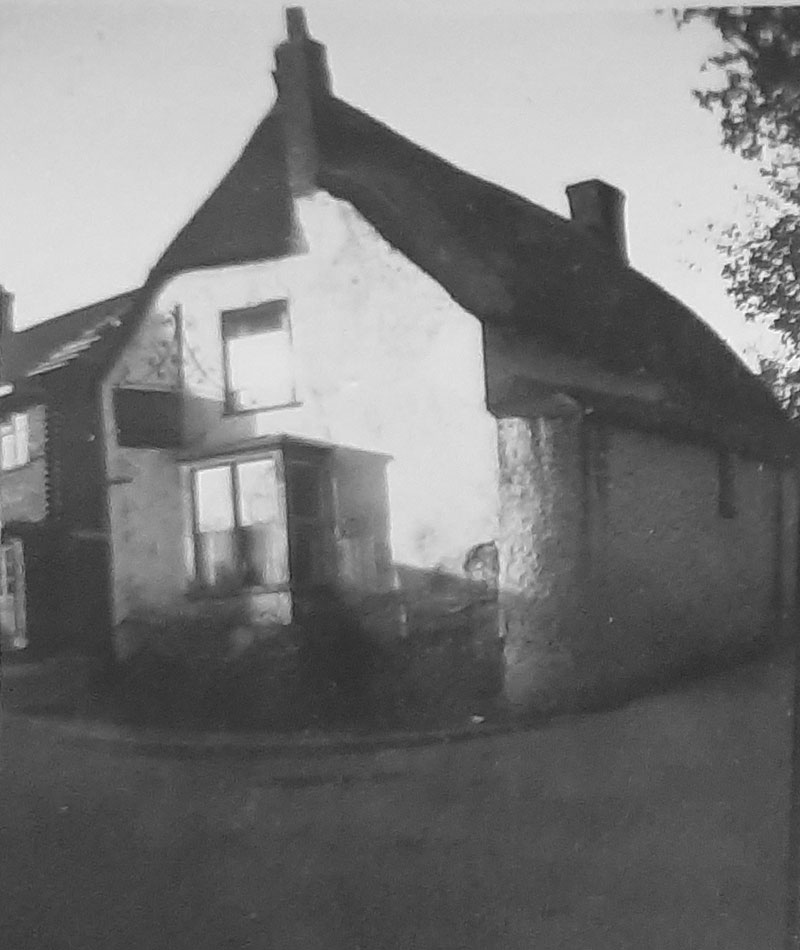
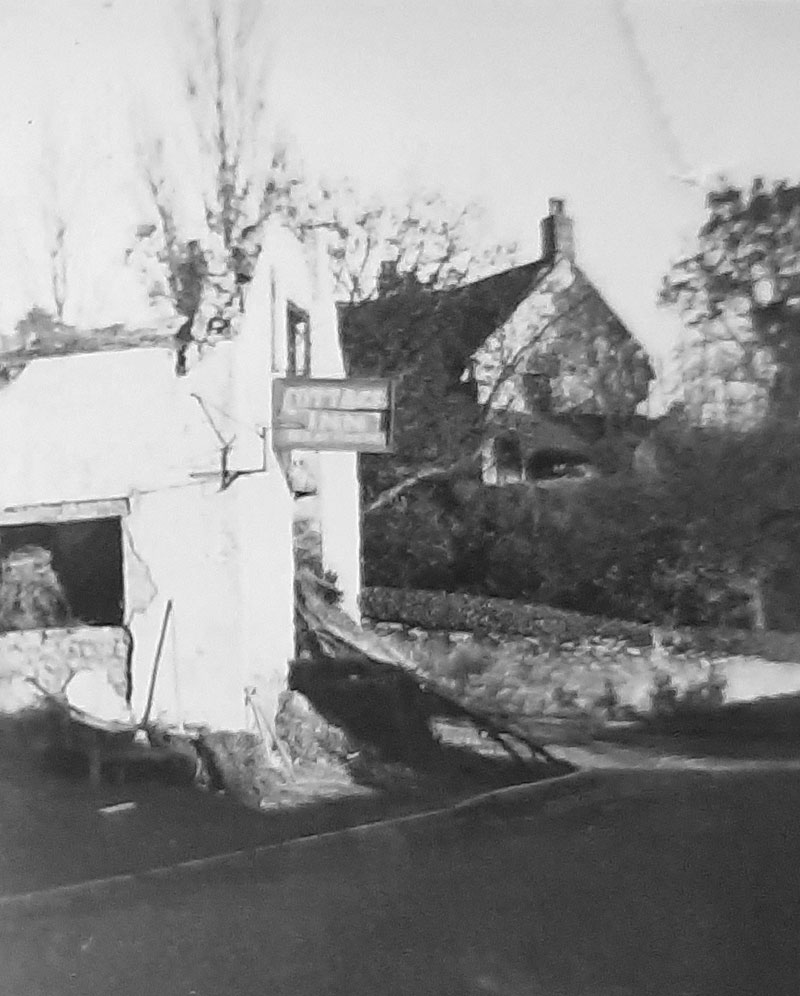
It seems Poole’s old club rooms of the 1850s/60s, were simply incorporated into the new building, albeit modified to a more modern style.
In 1940 Isaac was fined for breaking war-time black out.[22] In July 1946 the licence pasted from Isaac Haste to Alfred Denmark Sellar and the Sellars were still there in 1950.[23] A Mr Maisey was landlord in 1956.[24]
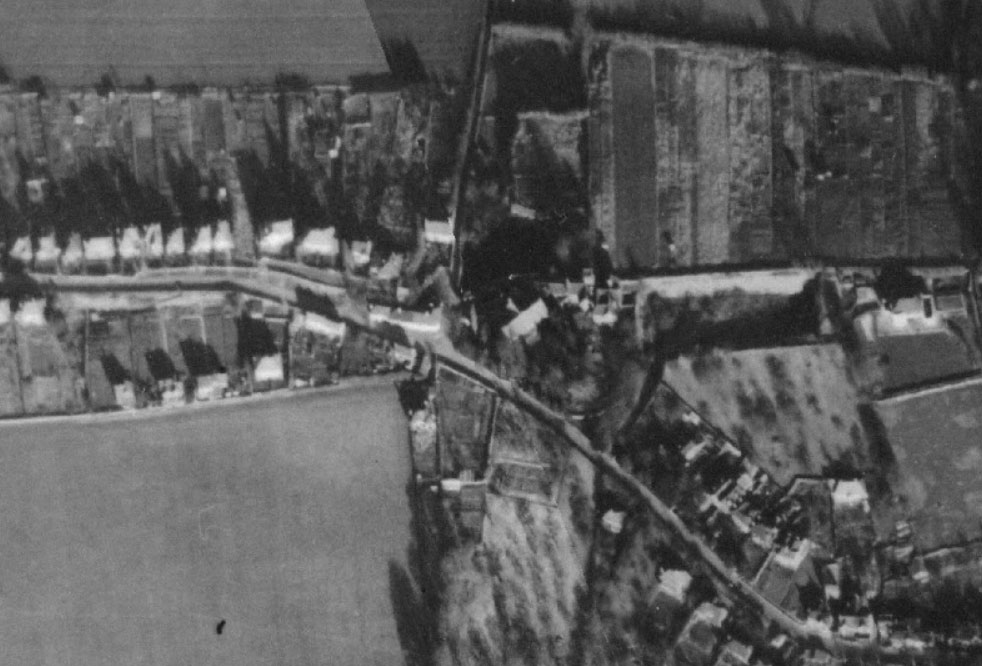
In 1962 a lorry crashed into a wall of the inn, damaging the wall and smashing a door. Major C.M. Ryman was landlord at the time.[25]
In 1970 there was an argument about people parking in front of the pub, and it was proposed to ban parking there. Landlord Peter Bruce said the parking restrictions would ruin his business, and a petition was gathered against the proposals, raising 100 signatures. The car park could only hold seven cars at the time.[26]
Do you have further details to help fill out this history? We’d be keen to hear from you, send us a line via the contact form.
Miles Kerr-Peterson, 9 March 2024
[1] Ekwall, Oxford Dictionary of English Place Names, 4th edn, 1960.
[2] Bridgwater Mercury, 14 June 1860; Western Daily Press, 24 January 1861.
[3] Sherborne Mercury, 20 October 1863.
[4] Western Gazette, 14 June 1867; The Bridgwater Mercury, 14 June 1876.
[5] Somerset County Gazette, 13 April 1867; Western Gazette 1 May 1868; West Somerset Free Press; 9 May 1868.
[6] Western Gazette, 5 April 1872.
[7] Langport & Somerton Herald, 14 February 1874.
[8] Western Gazette 14 February 1873.
[9] The Bridgwater Mercury, 23 August 1876.
[10] Western Gazette, 17 June 1892.
[11] Western Gazette, 28 June 1889.
[12] Somerset County Herald and Taunton Courier 3 August 1946; Western Daily Press, 13 October 1990.
[13] Somerset County Herald and Taunton Courier 4 March 1939; Somerset County Herald and Taunton Courier, 25 November 1961.
[14] Victoria County History.
[15] West Somerset free press, 1 September 1906
[16] Wells Journal, 7 September 1911; The Somerset Standard and Wilts and Dorset Advertiser 8 September 1911.
[17] West Somerset free press 24 February 1912.
[18] West Somerset Free Press, 14 September 1912.
[19] Langport & Somerton Herald, 4 February 1922.
[20] A Henry Gerald Haste, possibly his son, also lived here. Taunton Courier and Western Advertiser, 23 December 1939.
[21] Somerset County Herald and Taunton Courier. 21 May 1938.
[22] Somerset County Herald and Taunton Courier, 14 September 1940.
[23] Somerset County Herald and Taunton Courier, 13 July 1946; Somerset County Herald and Taunton Courier, 11 February 1950.
[24] Somerset County Herald and Taunton Courier, 10 March 1956.
[25] Taunton Courier and Western Advertiser, 10 February 1962.
[26] Bristol Evening Post, 31 December 1970; Bristol Evening Post, 5 January 1971; Western Daily Press 8 January 1971.
